Abstract
1. The acute and chronic effects of amiodarone were studied on the transmembrane ionic currents in rabbit single ventricular myocytes at 35 degrees C by applying the whole-cell configuration of the patch-clamp technique. 2. Acute exposure to 1 and 5 microM amiodarone significantly reduced the amplitude (-53.9 +/- 3.9%, n = 5 and -64.0 +/- 2.0%, n = 3, P < 0.01), but chronic amiodarone treatment (i.p. 50 mg kg-1 day-1 for 3-4 weeks) changed neither the amplitude nor the kinetics of the inward calcium current. 3. Both acute superfusion with amiodarone (1 and 5 microM) and chronic amiodarone treatment significantly decreased the amplitude of the delayed rectifier outward potassium current (IK). 4. Acute application of amiodarone (1 and 5 microM) did not alter but chronic amiodarone treatment moderately depressed the transient outward current (Ito). 5. Neither the acute (1 and 5 microM) nor the chronic amiodarone treatment changed the magnitude of the inward rectifier potassium current (Ik1). 6. It is concluded that acute amiodarone application and chronic amiodarone treatment alter transmembrane ionic currents of ventricular myocytes differently. This may explain, at least in part, the marked differences in the cardiac electrophysiological effects observed after acute and chronic amiodarone treatment in patients.
Full text
PDF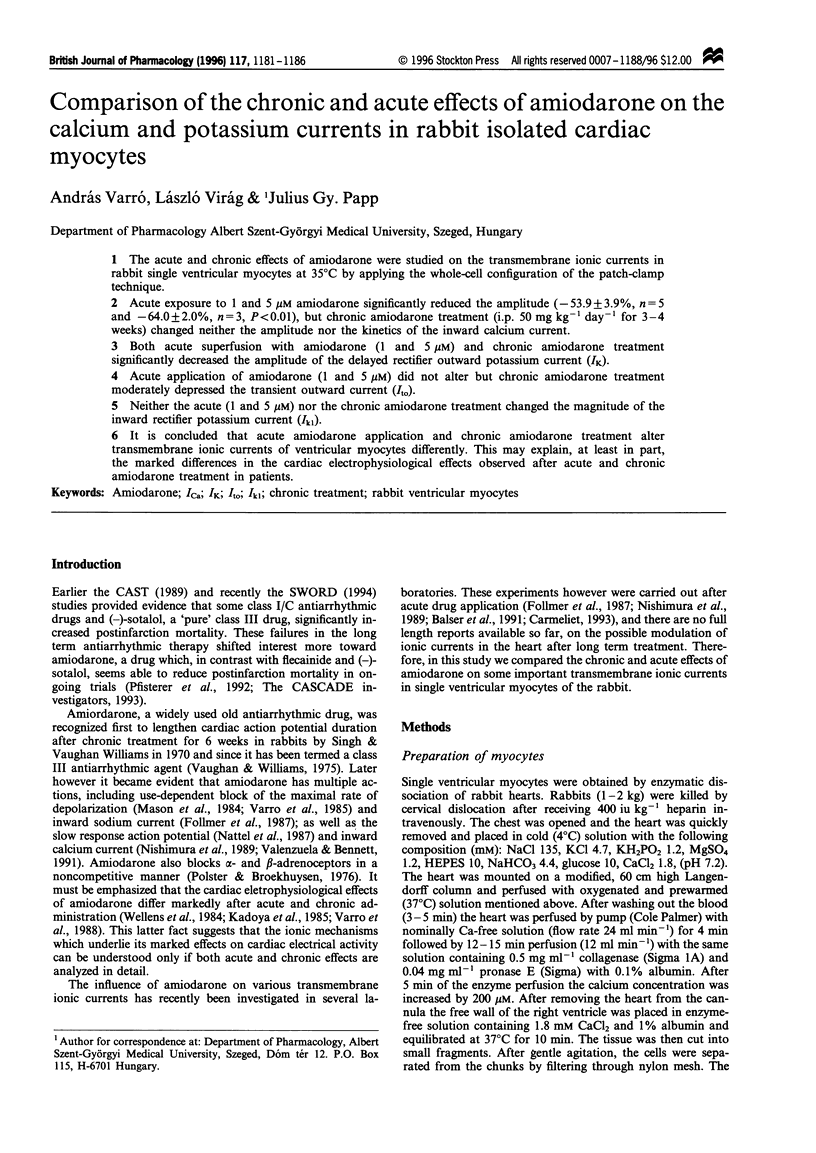
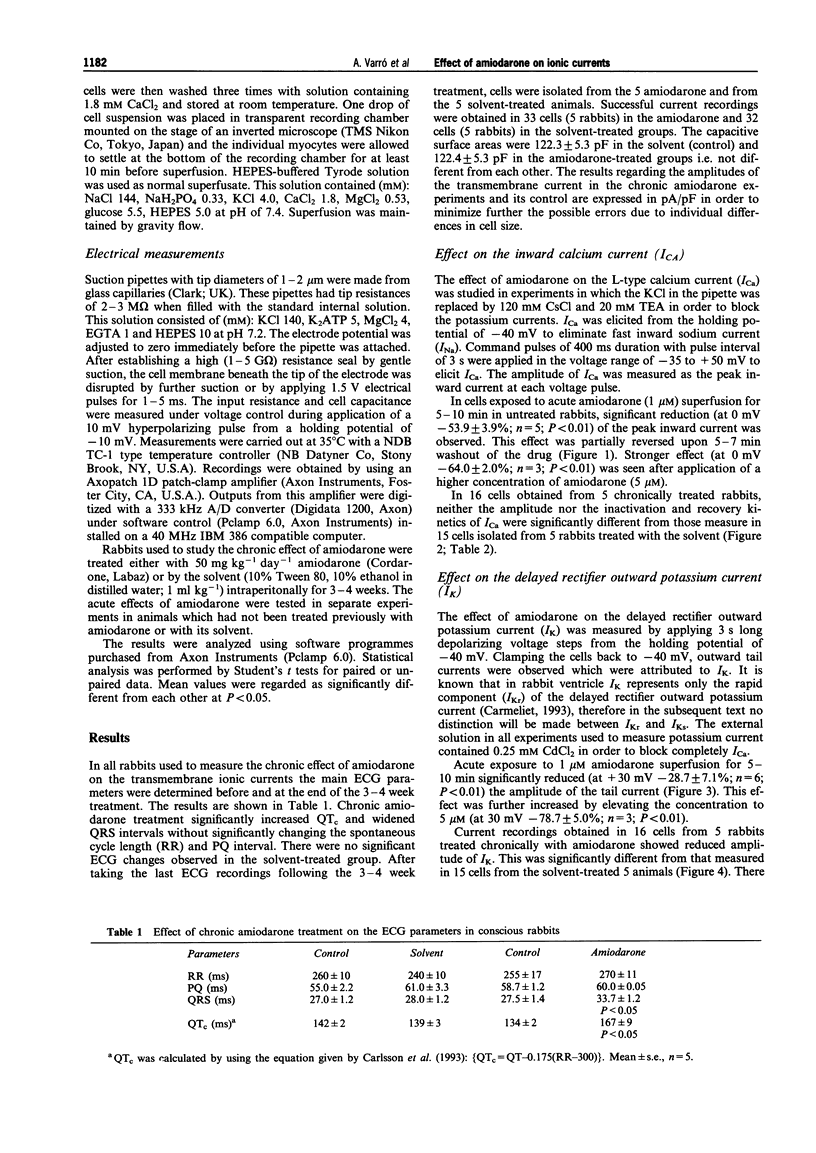
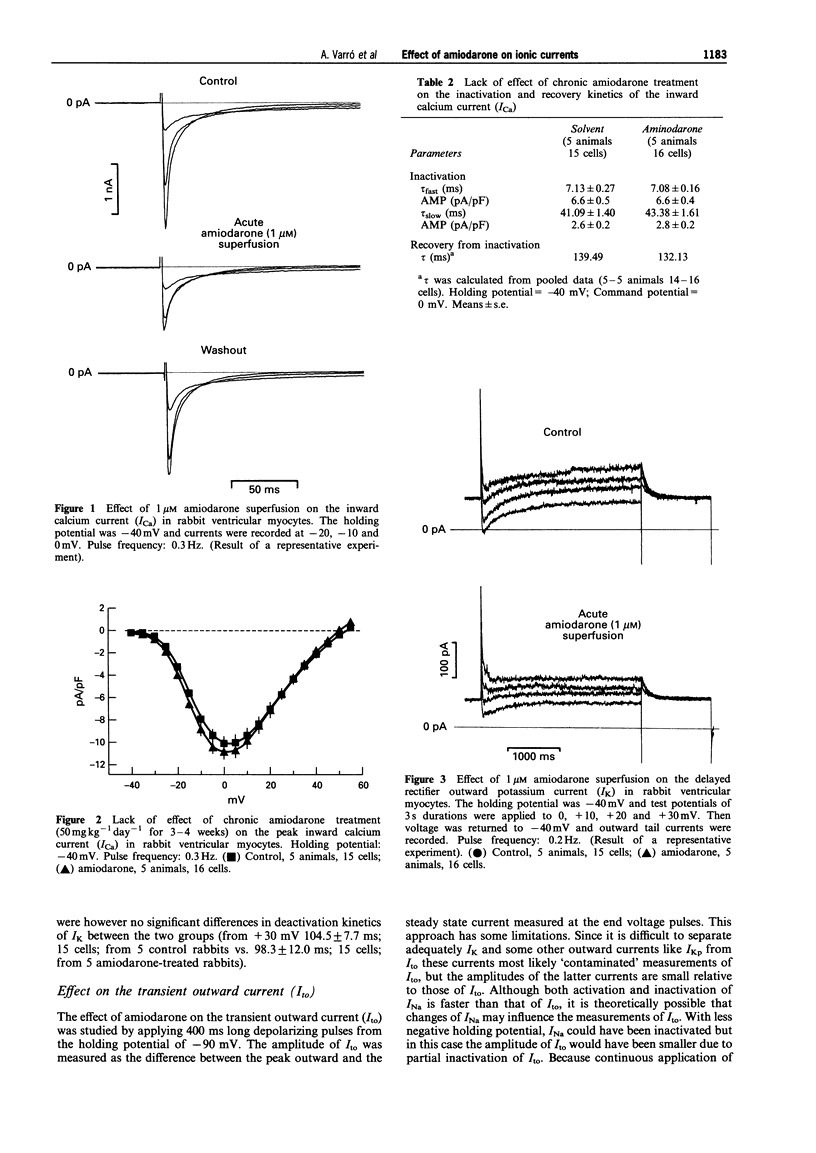
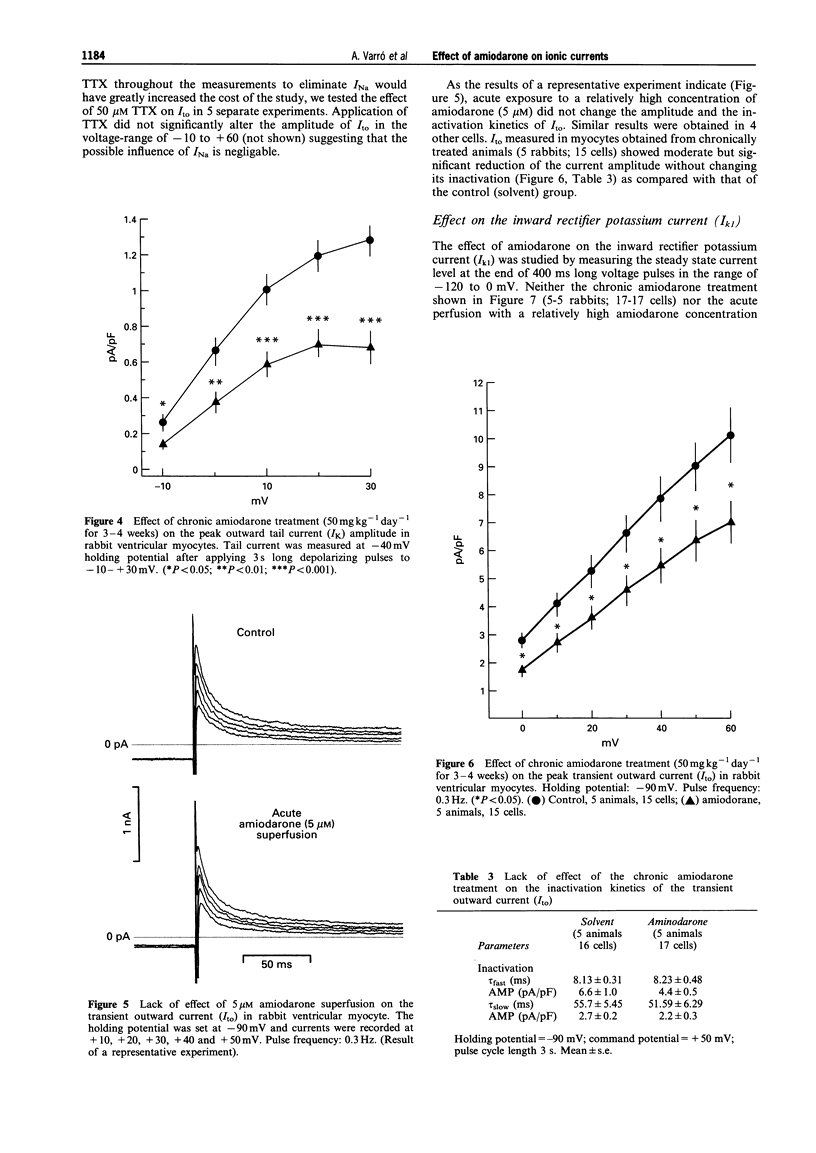
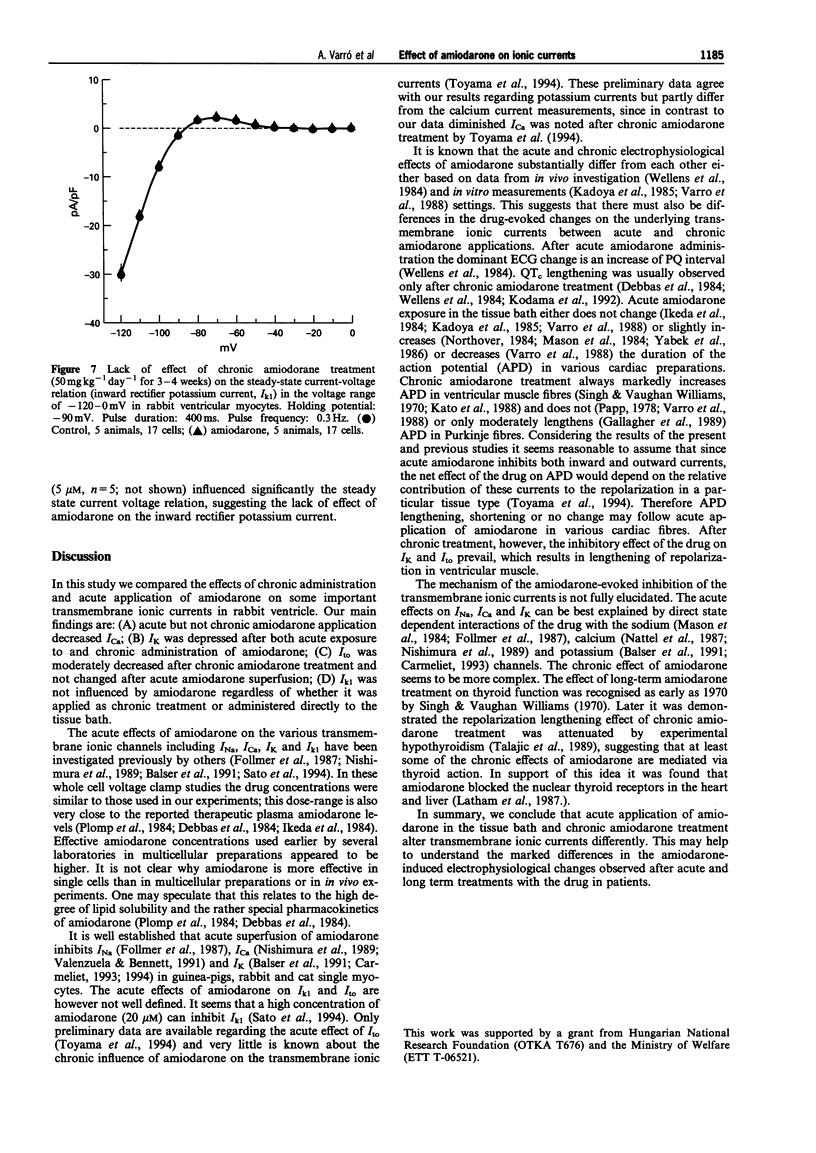
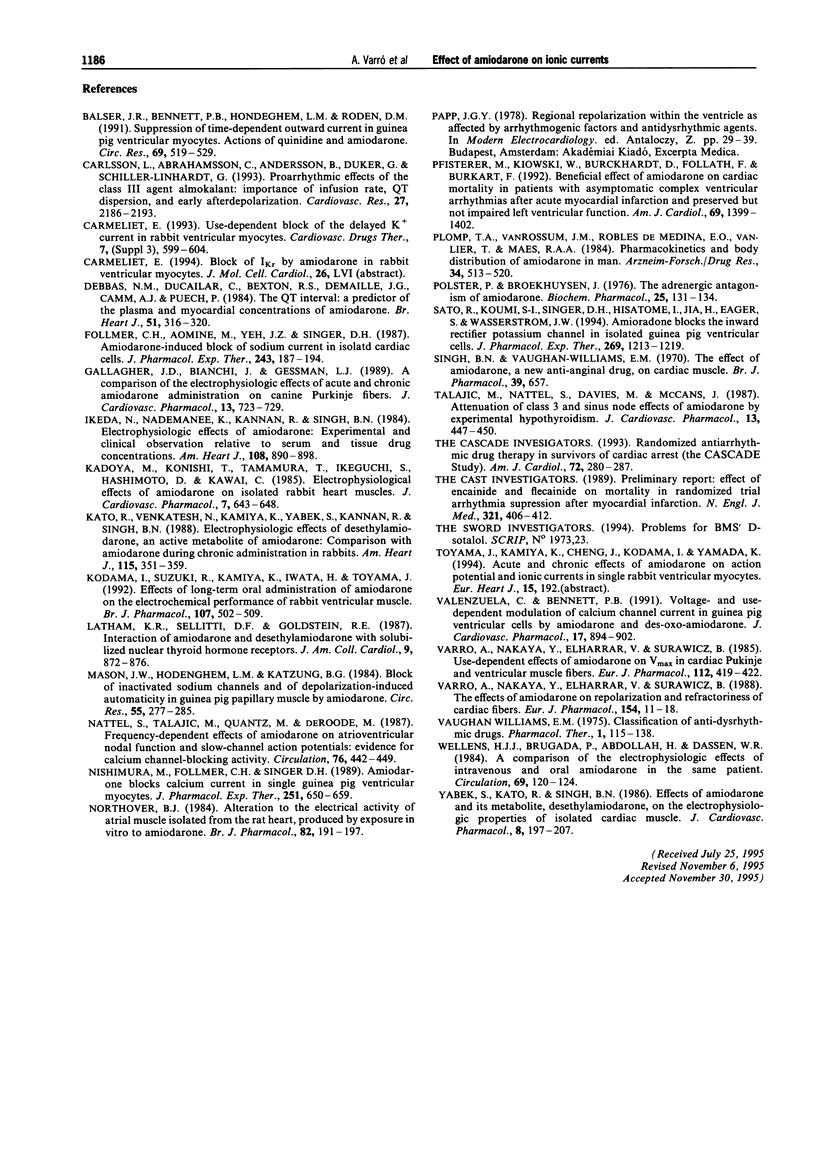
Selected References
These references are in PubMed. This may not be the complete list of references from this article.
- Balser J. R., Bennett P. B., Hondeghem L. M., Roden D. M. Suppression of time-dependent outward current in guinea pig ventricular myocytes. Actions of quinidine and amiodarone. Circ Res. 1991 Aug;69(2):519–529. doi: 10.1161/01.res.69.2.519. [DOI] [PubMed] [Google Scholar]
- Carlsson L., Abrahamsson C., Andersson B., Duker G., Schiller-Linhardt G. Proarrhythmic effects of the class III agent almokalant: importance of infusion rate, QT dispersion, and early afterdepolarisations. Cardiovasc Res. 1993 Dec;27(12):2186–2193. doi: 10.1093/cvr/27.12.2186. [DOI] [PubMed] [Google Scholar]
- Carmeliet E. Use-dependent block of the delayed K+ current in rabbit ventricular myocytes. Cardiovasc Drugs Ther. 1993 Aug;7 (Suppl 3):599–604. doi: 10.1007/BF00877626. [DOI] [PubMed] [Google Scholar]
- Debbas N. M., du Cailar C., Bexton R. S., Demaille J. G., Camm A. J., Puech P. The QT interval: a predictor of the plasma and myocardial concentrations of amiodarone. Br Heart J. 1984 Mar;51(3):316–320. doi: 10.1136/hrt.51.3.316. [DOI] [PMC free article] [PubMed] [Google Scholar]
- Follmer C. H., Aomine M., Yeh J. Z., Singer D. H. Amiodarone-induced block of sodium current in isolated cardiac cells. J Pharmacol Exp Ther. 1987 Oct;243(1):187–194. [PubMed] [Google Scholar]
- Gallagher J. D., Bianchi J., Gessman L. J. A comparison of the electrophysiologic effects of acute and chronic amiodarone administration on canine Purkinje fibers. J Cardiovasc Pharmacol. 1989 May;13(5):723–729. [PubMed] [Google Scholar]
- Ikeda N., Nademanee K., Kannan R., Singh B. N. Electrophysiologic effects of amiodarone: experimental and clinical observation relative to serum and tissue drug concentrations. Am Heart J. 1984 Oct;108(4 Pt 1):890–898. doi: 10.1016/0002-8703(84)90451-4. [DOI] [PubMed] [Google Scholar]
- Kadoya M., Konishi T., Tamamura T., Ikeguchi S., Hashimoto S., Kawai C. Electrophysiological effects of amiodarone on isolated rabbit heart muscles. J Cardiovasc Pharmacol. 1985 Jul-Aug;7(4):643–648. doi: 10.1097/00005344-198507000-00005. [DOI] [PubMed] [Google Scholar]
- Kato R., Venkatesh N., Kamiya K., Yabek S., Kannan R., Singh B. N. Electrophysiologic effects of desethylamiodarone, an active metabolite of amiodarone: comparison with amiodarone during chronic administration in rabbits. Am Heart J. 1988 Feb;115(2):351–359. doi: 10.1016/0002-8703(88)90481-4. [DOI] [PubMed] [Google Scholar]
- Kodama I., Suzuki R., Kamiya K., Iwata H., Toyama J. Effects of long-term oral administration of amiodarone on the electromechanical performance of rabbit ventricular muscle. Br J Pharmacol. 1992 Oct;107(2):502–509. doi: 10.1111/j.1476-5381.1992.tb12774.x. [DOI] [PMC free article] [PubMed] [Google Scholar]
- Latham K. R., Sellitti D. F., Goldstein R. E. Interaction of amiodarone and desethylamiodarone with solubilized nuclear thyroid hormone receptors. J Am Coll Cardiol. 1987 Apr;9(4):872–876. doi: 10.1016/s0735-1097(87)80244-9. [DOI] [PubMed] [Google Scholar]
- Mason J. W., Hondeghem L. M., Katzung B. G. Block of inactivated sodium channels and of depolarization-induced automaticity in guinea pig papillary muscle by amiodarone. Circ Res. 1984 Sep;55(3):278–285. doi: 10.1161/01.res.55.3.278. [DOI] [PubMed] [Google Scholar]
- Nattel S., Talajic M., Quantz M., DeRoode M. Frequency-dependent effects of amiodarone on atrioventricular nodal function and slow-channel action potentials: evidence for calcium channel-blocking activity. Circulation. 1987 Aug;76(2):442–449. doi: 10.1161/01.cir.76.2.442. [DOI] [PubMed] [Google Scholar]
- Nishimura M., Follmer C. H., Singer D. H. Amiodarone blocks calcium current in single guinea pig ventricular myocytes. J Pharmacol Exp Ther. 1989 Nov;251(2):650–659. [PubMed] [Google Scholar]
- Northover B. J. Alterations to the electrical activity of atrial muscle isolated from the rat heart, produced by exposure in vitro to amiodarone. Br J Pharmacol. 1984 May;82(1):191–197. doi: 10.1111/j.1476-5381.1984.tb16458.x. [DOI] [PMC free article] [PubMed] [Google Scholar]
- Pfisterer M., Kiowski W., Burckhardt D., Follath F., Burkart F. Beneficial effect of amiodarone on cardiac mortality in patients with asymptomatic complex ventricular arrhythmias after acute myocardial infarction and preserved but not impaired left ventricular function. Am J Cardiol. 1992 Jun 1;69(17):1399–1402. doi: 10.1016/0002-9149(92)90889-7. [DOI] [PubMed] [Google Scholar]
- Plomp T. A., van Rossum J. M., Robles de Medina E. O., van Lier T., Maes R. A. Pharmacokinetics and body distribution of amiodarone in man. Arzneimittelforschung. 1984;34(4):513–520. [PubMed] [Google Scholar]
- Polster P., Broekhuysen J. The adrenergic antagonism of amiodarone. Biochem Pharmacol. 1976 Jan 15;25(2):131–134. doi: 10.1016/0006-2952(76)90279-3. [DOI] [PubMed] [Google Scholar]
- Sato R., Koumi S., Singer D. H., Hisatome I., Jia H., Eager S., Wasserstrom J. A. Amiodarone blocks the inward rectifier potassium channel in isolated guinea pig ventricular cells. J Pharmacol Exp Ther. 1994 Jun;269(3):1213–1219. [PubMed] [Google Scholar]
- Singh B. N., Vaughan Williams E. M. The effect of amiodarone, a new anti-anginal drug, on cardiac muscle. Br J Pharmacol. 1970 Aug;39(4):657–667. doi: 10.1111/j.1476-5381.1970.tb09891.x. [DOI] [PMC free article] [PubMed] [Google Scholar]
- Talajic M., Nattel S., Davies M., McCans J. Attenuation of class 3 and sinus node effects of amiodarone by experimental hypothyroidism. J Cardiovasc Pharmacol. 1989 Mar;13(3):447–450. doi: 10.1097/00005344-198903000-00013. [DOI] [PubMed] [Google Scholar]
- Valenzuela C., Bennett P. B. Voltage- and use-dependent modulation of calcium channel current in guinea pig ventricular cells by amiodarone and des-oxo-amiodarone. J Cardiovasc Pharmacol. 1991 Jun;17(6):894–902. doi: 10.1097/00005344-199106000-00006. [DOI] [PubMed] [Google Scholar]
- Varro A., Nakaya Y., Elharrar V., Surawicz B. Use-dependent effects of amiodarone on Vmax in cardiac Purkinje and ventricular muscle fibers. Eur J Pharmacol. 1985 Jun 19;112(3):419–422. doi: 10.1016/0014-2999(85)90791-5. [DOI] [PubMed] [Google Scholar]
- Varró A., Nakaya Y., Elharrar V., Surawicz B. The effects of amiodarone on repolarization and refractoriness of cardiac fibers. Eur J Pharmacol. 1988 Sep 1;154(1):11–18. doi: 10.1016/0014-2999(88)90357-3. [DOI] [PubMed] [Google Scholar]
- Vaughan Williams E. M. Classification of antidysrhythmic drugs. Pharmacol Ther B. 1975;1(1):115–138. doi: 10.1016/0306-039x(75)90019-7. [DOI] [PubMed] [Google Scholar]
- Wellens H. J., Brugada P., Abdollah H., Dassen W. R. A comparison of the electrophysiologic effects of intravenous and oral amiodarone in the same patient. Circulation. 1984 Jan;69(1):120–124. doi: 10.1161/01.cir.69.1.120. [DOI] [PubMed] [Google Scholar]
- Yabek S. M., Kato R., Singh B. N. Effects of amiodarone and its metabolite, desethylamiodarone, on the electrophysiologic properties of isolated cardiac muscle. J Cardiovasc Pharmacol. 1986 Jan-Feb;8(1):197–207. doi: 10.1097/00005344-198601000-00029. [DOI] [PubMed] [Google Scholar]


